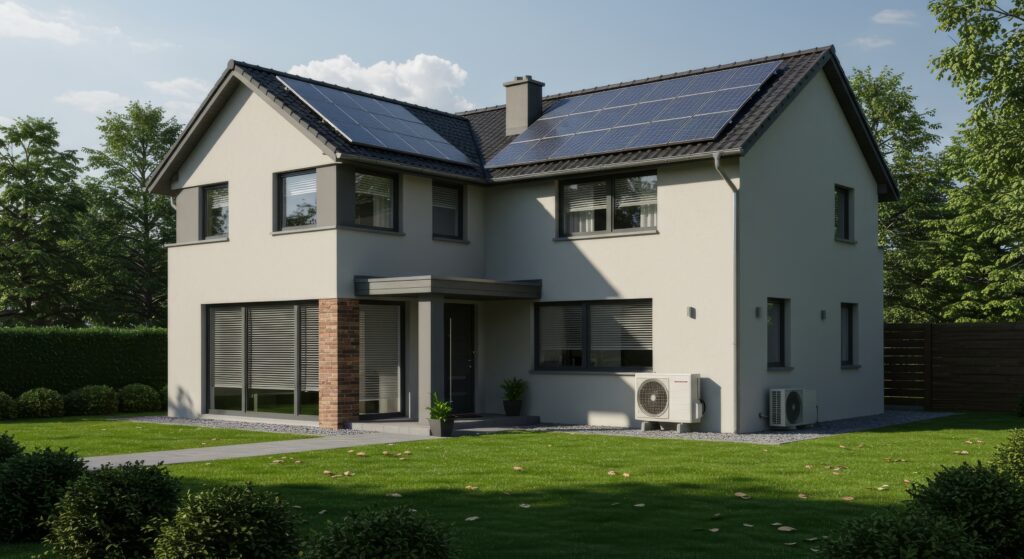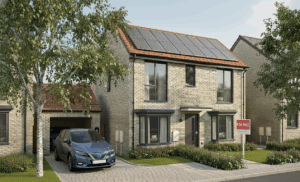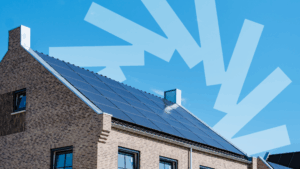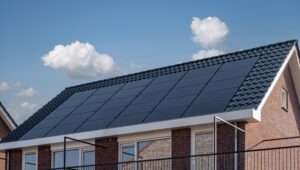With gas boilers increasingly being phased out, all-electric heating systems – particularly air source heat pumps (ASHPs) – are becoming the default for new homes. Yet this shift brings challenges: higher electrical loads, greater exposure to energy price volatility, and the need to manage SAP performance carefully.
Integrating smart solar systems alongside ASHPs offers one of the most effective ways to mitigate these issues, reducing running costs and improving energy ratings.
This guide explores how a solar and heat pump combo performs in practice, how it affects homeowner bills, and why early design-stage planning is key.
The Electrical Impact of Heat Pumps
Air source heat pumps are more efficient than gas boilers, often delivering 3–4 units of heat per 1 unit of electricity. However, they represent a significant shift in energy profile from gas to electricity, which has cost and design implications.
For example, a three-bedroom home using an ASHP might require an additional 3,500 to 4,500 kWh of electricity per year for heating alone. This raises total electricity demand substantially and leaves homeowners more exposed to fluctuations in electricity prices. Electricity currently costs around four times as much as gas per kWh. This means that annual heating bills can quickly outpace those of traditional gas systems without onsite energy generation to offset the load.
It’s also important to consider how ASHPs are typically used. Unlike gas systems, which deliver short bursts of high-temperature heat, ASHPs work best when running continuously at lower temperatures to maintain a steady indoor climate. This shift results in a flatter energy demand profile but a higher base load, especially overnight when solar panels aren’t generating. Without a battery, this extra demand has to come from the grid.
A battery storage system enables excess solar energy to be stored and used overnight, reducing a home’s reliance on the grid and protecting the household from volatile electricity prices.
Real-World Scenario: ASHP with and without Solar
To illustrate how different energy and heating systems affect running costs, let’s take a typical three-bedroom, semi-detached home in the UK as an example:
Estimated Annual Energy Costs for a Three-Bedroom Home
| System Type | Annual Energy Cost (Heating & Hot Water Only) | Key Assumptions |
| Gas Boiler Only (No Solar) | £1,200 | Assumes energy demand of ~12,000 kWh gas/year |
| ASHP Only (No Solar) | £1,350 | ~4,500 kWh added to standard energy demand |
| ASHP + 5.5kW Solar | £950 | Rooftop solar yield offsets ~20–40% of demand |
| ASHP + Gryd Smart Solar System (inc Battery Storage & Optimisation) | £800 | Smart ongoing optimisation of solar and ASHP load. Including a battery increases the usable generation to ~70%+ |
A 5.5kW solar system (producing ~4,500–5,000 kWh/year) can cover a substantial portion of both heating and general household electricity needs, particularly when paired with controls and battery storage.
Figures are based on 2025 average unit prices (electricity @ £0.30/kWh, gas @ £0.10/kWh).
SAP Score Implications for Electric Heating
As of SAP 10.2 – and with SAP 11 changes expected soon – electric heating systems receive more favourable treatment when paired with renewables. Key considerations include:
- Lower primary energy and emissions factors when solar is used on-site
- Improved Dwelling Emission Rate (DER) performance
- Easier compliance with Part L and Future Homes Standard thresholds
Homes using gas-only systems will find it increasingly difficult to meet compliance without additional compensatory measures such as insulation or costly renewable offsets. By contrast, homes using ASHPs with solar PV are likely to perform more strongly from the outset – especially in terms of SAP scoring and EPC banding.
Building for Long-Term Performance
The shift to electric heating in new builds is already well underway. While ASHPs are a core part of this shift, their effectiveness – both in meeting regulations and managing long-term energy costs – is greatly enhanced when integrated with solar PV and intelligent control systems from the outset.
Design-stage planning is critical. It enables correct sizing of heat pump systems, optimal solar orientation, and the seamless integration of energy storage or smart load-shifting technologies. These early decisions have a direct impact on SAP scores, EPC banding, and the overall marketability of the home.
For developers looking to integrate solar effectively alongside heat pump systems, Gryd can advise on system sizing, generation modelling, and smart energy controls that maximise on-site usage and improve SAP scores. While we don’t specify or install heat pumps, we work closely with housebuilders to ensure our smart solar systems are deployed in a way that supports the broader energy strategy of the home.
To explore how Gryd can support your next development, get in touch.



